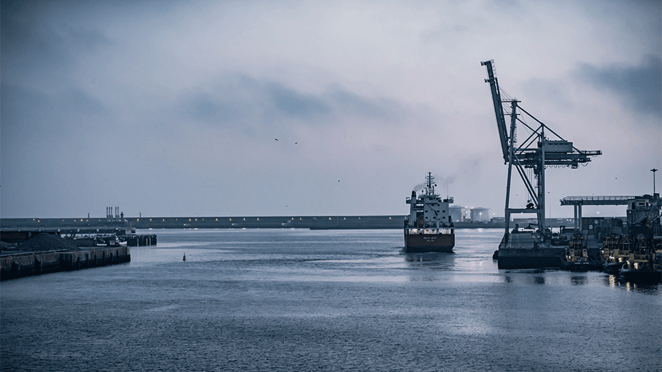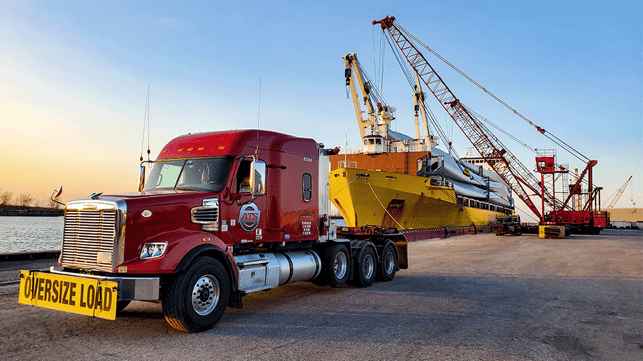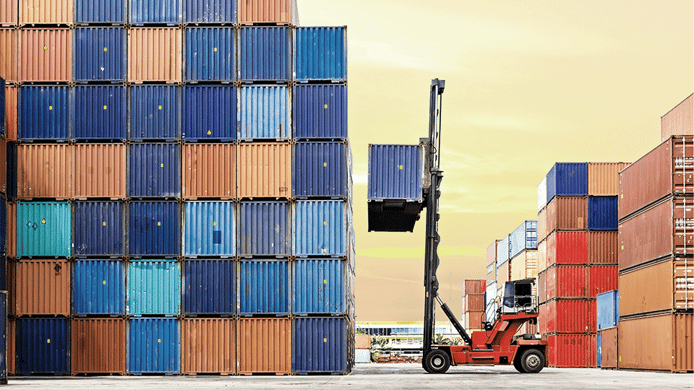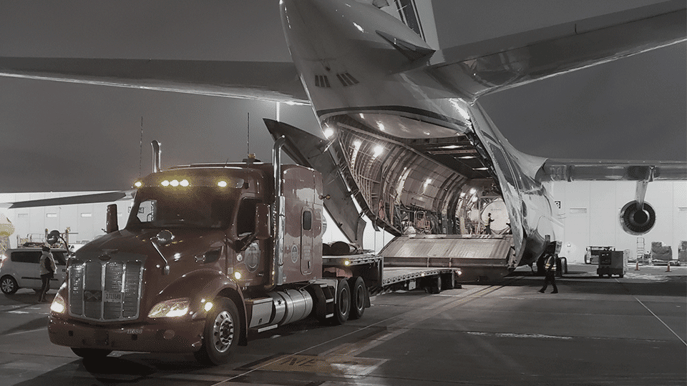The transportation industry is brimming with terminology, acronyms, and abbreviations that are unique to the business of freight movement.
To the uninitiated, the sheer amount of things to learn and variables to manage can be overwhelming.
When transportation’s complexities make it difficult to understand the prices you’re paying or the things you need to do to make your shipment a success, your questions should never go unanswered.
Incoterms have an impact on the supply chains of businesses around the world as they work to move cargos expeditiously. Despite their importance in global trade, they're also easily misunderstood due to their complexity.
Here at Anderson Trucking Service (ATS), we’ve been helping companies decipher their incoterms for decades now. As a result, we understand the profound place they hold in the transportation world and what each of them means.
In this article, we’ll answer all of your incoterm-specific questions so that you have no trouble understanding your transportation terms of sale going forward.
What Are Incoterms?
Incoterms (short for “international commercial terms") are a set of globally-recognized trade terms that define the terms of sale between buyers and sellers of international goods.
There are 11 incoterms in total. Broken into two categories based on the transactions to which they apply, these 11 terms clearly outline the division of costs, risks, and responsibilities between both the buyer and seller for payment and goods handled during international shipping activities.
Incoterms are developed, updated and released by the International Chamber of Commerce (ICC), and are typically revised every 10 years.
Currently, the industry uses the 2020 incoterms, with the next update expected in 2030.
Why Do Incoterms Matter?
With 197 countries in the world, each boasting a unique set of rules and regulations, moving cargo between them can be confusing.
In 1936, the International Chamber of Commerce developed incoterms to simplify this process and to promote global economic prosperity and trade.
Incoterms are used as shorthand by companies around the world to set the terms of their contracted arrangements, achieving the goal originally set by the ICC.
Without their assistance, international business transactions would be far more complex.
Budgeting for these transactions would be more difficult for all parties involved and, without understanding which charges must be paid by who — and which party assumes the risk of cargo damage, theft or mishap when — supply chains would stall.
For this reason, it’s important that you firmly understand each incoterm and what they mean for you should you encounter them. With this knowledge, there will be little to no confusion as to what’s expected of you on each transaction. And, in turn, the transportation of your cargo will go smoothly from A to B.
What Do Incoterms Determine?
Incoterms are used to specify which party (buyer or seller) will pay for the various aspects of, and charges associated with a load’s transport. For the vast majority of shipments, the corresponding incoterm covers the following 11 charges:
- Freight packaging
- Loading charges
- Delivery to port/place
- Export duties and taxes
- Origin terminal charges
- Loading on-carriage costs
- Carriage charges
- Insurance costs
- Destination terminal charges
- Delivery to the destination location
- Import duties and taxes
Often, determining and communicating who’s responsible for paying for each of these fees can be difficult to do at the point of sale. As such, the universally recognized shorthand of the 11 incoterms makes a valuable addition to this process.
What Are The 11 Incoterms In 2025?
The 11 incoterms used for international freight shipping transactions, organized based on the responsibility shouldered by the seller (from least to most), are:
- Ex Works (EXW)
- Free Carrier (FCA)
- Free Alongside Ship (FAS)
- Free On Board (FOB)
- Cost and Freight (CFR)
- Cost, Insurance and Freight (CIF)
- Carriage Paid To (CPT)
- Carriage and Insurance Paid To (CIP)
- Delivered at Place Unloaded (DPU)
- Delivered at Place (DAP)
- Delivered Duty Paid (DDP)
To break these down a bit further, in 2010 these incoterms were separated into two categories based on the method used to transport them.
Category 1: Incoterms Used For Any Mode of Transport
These seven Incoterms apply to any mode of freight transportation, whether by land, rail, sea or air:
- Ex Works (EXW)
- Free Carrier (FCA)
- Carriage Paid To (CPT)
- Carriage and Insurance Paid To (CIP)
- Delivered at Place Unloaded (DPU)
- Delivered at Place (DAP)
- Delivered Duty Paid (DDP)
Category 2: Incoterms Solely Used for Sea/Inland Waterway Transport
These four incoterms solely apply to freight transported via sea and/or waterway and won’t be seen on shipments transported in other ways:
- Free Alongside Ship (FAS)
- Free On Board (FOB)
- Cost and Freight (CFR)
- Cost, Insurance and Freight (CIF)
Regardless of which mode of transport your shipment will utilize, it’s important that you understand what you’re responsible for (as the buyer or seller) as defined by each incoterm.

Ex Works (EXW) Incoterm
This incoterm places the least amount of risk/responsibility on the seller's shoulders. The seller is solely responsible for packaging and making the goods available for pickup. The buyer must then arrange and cover everything else, including:
- Freight packaging – Seller
- Loading charges – Buyer
- Delivery to port/place – Buyer
- Export duties and taxes – Buyer
- Origin terminal charges – Buyer
- Loading on-carriage costs – Buyer
- Carriage charges – Buyer
- Insurance costs – Buyer
- Destination terminal charges – Buyer
- Delivery to the destination location – Buyer
- Import duties and taxes – Buyer
Free Carrier (FCA) Incoterm
After EXW, the FCA incoterm requires the least amount of responsibility from the seller. The “Free Carrier” incoterm stipulates that the seller of the freight cover charges and arrangements up to the moment it arrives at the export location stipulated by the buyer. Once the goods are handed over to the carrier, the risk transfers to the buyer.
The free carrier incoterm breaks responsibilities down as follows:
- Freight packaging – Seller
- Loading charges – Seller
- Delivery to port/place – Seller
- Export duties and taxes – Seller
- Origin terminal charges – Buyer
- Loading on-carriage costs – Buyer
- Carriage charges – Buyer
- Insurance costs – Negotiable
- Destination terminal charges – Buyer
- Delivery to the destination location – Buyer
- Unloading at destination location - Buyer
- Import duties and taxes – Buyer
Free Alongside Ship (FAS) Incoterm
The "Free Alongside Ship" incoterm applies solely to sea/waterway transportation. When included in an international trade contract, the FAS incoterm indicates that the seller of cargo must pay for the movement of goods from the moment it leaves their facility until its safely situated alongside its selected vessel for loading. Risk transfers to the buyer at this point; they are responsible for the main portion of transit and all subsequent steps in delivery.
FAS incoterms dole out duties, charges, and fees as follows:
- Freight packaging – Seller
- Loading charges - Seller
- Delivery to port/place - Seller
- Export duties and taxes - Seller
- Origin terminal charges - Seller
- Loading on-carriage costs - Buyer
- Carriage charges - Buyer
- Insurance costs - Negotiable
- Destination terminal charges - Buyer
- Delivery to the destination location - Buyer
- Unloading at destination location - Buyer
- Import duties and taxes - Buyer
Free On Board (FOB) Incoterm
The “Free On Board” incoterm specifies that the seller of a product will arrange for its packaging, transportation to the port and safe loading onto its selected marine vessel — paying for all fees, duties and taxes along the way. After the freight in question is "on board" the ship transporting it, responsibility transfers to the buyer for all subsequent arrangements/charges.
Here is the breakdown of responsibility for the FOB incoterm:
- Freight packaging – Seller
- Loading charges - Seller
- Delivery to port/place - Seller
- Export duties and taxes - Seller
- Origin terminal charges - Seller
- Loading on-carriage costs - Seller
- Carriage charges - Buyer
- Insurance costs - Negotiable
- Destination terminal charges - Buyer
- Delivery to the destination location - Buyer
- Unloading at destination location - Buyer
- Import duties and taxes - Buyer
Cost and Freight (CFR) Incoterm
“Cost and Freight” is another incoterm that only applies to transactions where a shipment will be transported to its destination location via marine vessel. CFR incoterms require the seller to handle transportation to the port of origin and for loading the goods onto the vessel.
It's important to note that while CFR places responsibility of transportation to the destination port on the seller, the seller is not liable for that portion of the journey. That risk transfers to the buyer upon onboarding of the goods at the port of origin.
The CFR incoterm defines responsibilities as:
- Freight packaging – Seller
- Loading charges - Seller
- Delivery to port/place - Seller
- Export duties and taxes - Seller
- Origin terminal charges - Seller
- Loading on-carriage costs - Seller
- Carriage charges - Seller
- Insurance costs - Negotiable
- Destination terminal charges - Buyer
- Delivery to the destination location - Buyer
- Unloading at destination location - Buyer
- Import duties and taxes - Buyer
Cost, Insurance, and Freight (CIF) Incoterm
Also applicable only to sea/waterway faring goods, "Cost, Insurance, and Freight" incoterms require the same commitment from the seller as a CFR incoterm would, with the added stipulation that the seller pay insurance costs. As such, the breakdown of charges for the CIF incoterm is:
- Freight packaging – Seller
- Loading charges - Seller
- Delivery to port/place - Seller
- Export duties and taxes - Seller
- Origin terminal charges - Seller
- Loading on-carriage costs - Seller
- Carriage charges - Seller
- Insurance costs - Seller
- Destination terminal charges - Buyer
- Delivery to the destination location - Buyer
- Unloading at destination location - Buyer
- Import duties and taxes - Buyer
Carriage Paid To (CPT) Incoterm
An incoterm that can be applied to any shipment, the CPT marking on an international contract requires the seller to handle the payments and arrangements associated with transportation until the goods reach an agreed-upon destination. Once the goods are handed over to a carrier at that destination, the buyer then assumes all risk.
“Carriage Paid To” incoterms separate responsibilities accordingly:
- Freight packaging – Seller
- Loading charges - Seller
- Delivery to port/place - Seller
- Export duties and taxes - Seller
- Origin terminal charges - Seller
- Loading on-carriage costs - Seller
- Carriage charges - Seller
- Insurance costs - Buyer
- Destination terminal charges - Negotiable
- Delivery to the destination location - Buyer
- Unloading at destination location - Buyer
- Import duties and taxes - Buyer
Carriage and Insurance Paid To (CIP) Incoterm
Similar the the “Carriage Paid To” incoterm, the "Carriage and Insurance Paid To" incoterm lays the burden of responsibility on the seller up until products reach the buyer’s designated destination terminal, but with the additional stipulation that the seller will take care of all cargo insurance costs.
CIP incoterms break down responsibilities thusly:
- Freight packaging – Seller
- Loading charges - Seller
- Delivery to port/place - Seller
- Export duties and taxes - Seller
- Origin terminal charges - Seller
- Loading on-carriage costs - Seller
- Carriage charges - Seller
- Insurance costs - Seller
- Destination terminal charges - Seller
- Delivery to the destination location - Buyer
- Unloading at destination location - Buyer
- Import duties and taxes - Buyer
Delivered at Place Unloaded (DPU) Incoterm
When a “Delivered at Place Unloaded” incoterm is utilized, the buyer of a product is only responsible for paying its import duties, taxes and fees. Everything else — from its packaging to transportation to the agreed-upon destination to unloading the goods upon arrival — is paid for by the seller.
Here's a list of how DPU incoterm responsibilities break down:
- Freight packaging – Seller
- Loading charges - Seller
- Delivery to port/place - Seller
- Export duties and taxes - Seller
- Origin terminal charges - Seller
- Loading on-carriage costs - Seller
- Carriage charges - Seller
- Insurance costs - Negotiable
- Destination terminal charges - Seller
- Delivery to the destination location - Seller
- Unloading at destination location - Seller
- Import duties and taxes - Buyer
Delivered at Place (DAP) Incoterm
The "Delivered at Place" incoterm is similar to DPU incoterms, but places the responsibility of unloading the goods at the destination on the buyer. The buyer takes on all further risks and costs from that point forward.
- Freight packaging – Seller
- Loading charges - Seller
- Delivery to port/place - Seller
- Export duties and taxes - Seller
- Origin terminal charges - Seller
- Loading on-carriage costs - Seller
- Carriage charges - Seller
- Insurance costs - Negotiable
- Destination terminal charges - Seller
- Delivery to the destination location - Seller
- Unloading at destination location - Buyer
- Import duties and taxes - Buyer

Delivered Duty Paid (DDP) Incoterm
The “Delivered Duty Paid” incoterm places the maximum responsibility on the seller. With the exception of cargo insurance — the purchaser of which varies by situation — the transportation of goods that have the DDP incoterm associated with them is fully paid for and managed by the seller.
- Freight packaging – Seller
- Loading charges - Seller
- Delivery to port/place - Seller
- Export duties and taxes - Seller
- Origin terminal charges - Seller
- Loading on-carriage costs - Seller
- Carriage charges - Seller
- Insurance costs - Negotiable
- Destination terminal charges - Seller
- Delivery to the destination location - Seller
- Unloading at destination location - Seller
- Import duties and taxes - Seller
Incoterms Chart of Responsibility
| Any Transport Mode | Sea/Inland Waterway | Any Transport Mode | |||||||||
| EXW | FCA | FAS | FOB | CFR | CIF | CPT | CIP | DPU | DAP | DDP | |
| Charges/Fees | Ex Works | Free Carrier | Free Alongside Ship | Free Onboard | Cost and Freight | Cost, Insurance and Freight | Carriage Paid To | Carriage and Insurance Paid To | Delivered at Place Unloaded | Delivered at Place | Delivered Duty Paid |
| Packaging | Seller | Seller | Seller | Seller | Seller | Seller | Seller | Seller | Seller | Seller | Seller |
| Loading Charges | Buyer | Seller | Seller | Seller | Seller | Seller | Seller | Seller | Seller | Seller | Seller |
| Delivery to Port/Place | Buyer | Seller | Seller | Seller | Seller | Seller | Seller | Seller | Seller | Seller | Seller |
| Export Duty & Taxes | Buyer | Seller | Seller | Seller | Seller | Seller | Seller | Seller | Seller | Seller | Seller |
| Origin Terminal Charges | Buyer | Buyer | Seller | Seller | Seller | Seller | Seller | Seller | Seller | Seller | Seller |
| Loading On Carriage | Buyer | Buyer | Buyer | Seller | Seller | Seller | Seller | Seller | Seller | Seller | Seller |
| Carriage Charges | Buyer | Buyer | Buyer | Buyer | Seller | Seller | Seller | Seller | Seller | Seller | Seller |
| Insurance | Negotiable | Seller | Seller | ||||||||
| Destination Terminal Charges | Buyer | Buyer | Buyer | Buyer | Buyer | Buyer | Seller | Seller | Seller | Seller | Seller |
| Delivery To Destination | Buyer | Buyer | Buyer | Buyer | Buyer | Buyer | Buyer | Buyer | Seller | Seller | Seller |
| Unloading at Destination | Buyer | Buyer | Buyer | Buyer | Buyer | Buyer | Buyer | Buyer | Buyer | Seller | Seller |
| Import Duty and Taxes | Buyer | Buyer | Buyer | Buyer | Buyer | Buyer | Buyer | Buyer | Buyer | Buyer | Seller |
Let’s Talk About Your Freight Rates
Now that you understand what incoterms are, how they impact freight shipping across the world and what each of them mean for both buyers and sellers, you’re one step closer to maximizing your transportation spend.
While having a firm understanding of international commercial terms and the important role they play in the movement of your goods is important, understanding your freight rates will take a bit more effort.
Every shipment — whether around the globe or across town — is priced based on a variety of factors. Knowledge of these factors and the things that influence them helps shippers take their budgets further as they control what they can.
Check out our Pricing Page and the accompanying pieces of content for some insights into what you should expect to pay for your next shipment.
If you have any questions about your freight rate or how ATS can help you move your next load, don’t hesitate to reach out. We’re happy to help you in any way you need.






